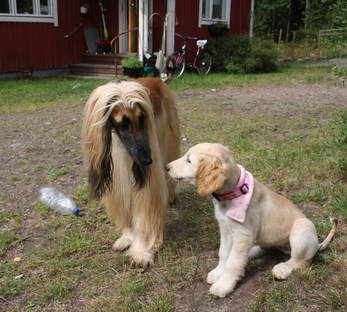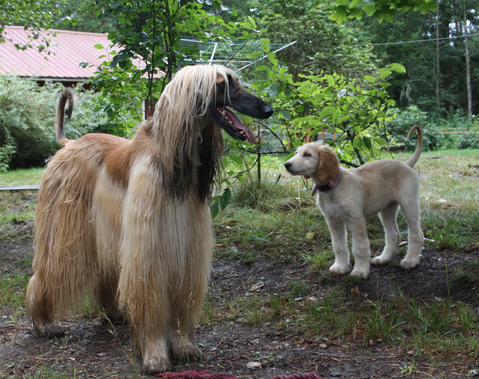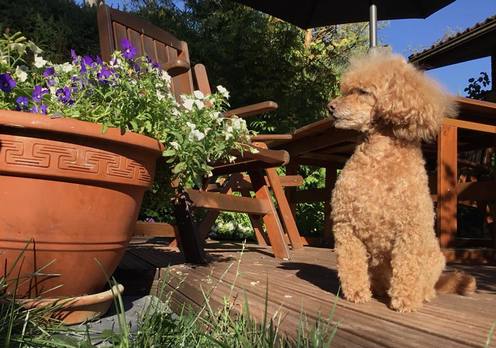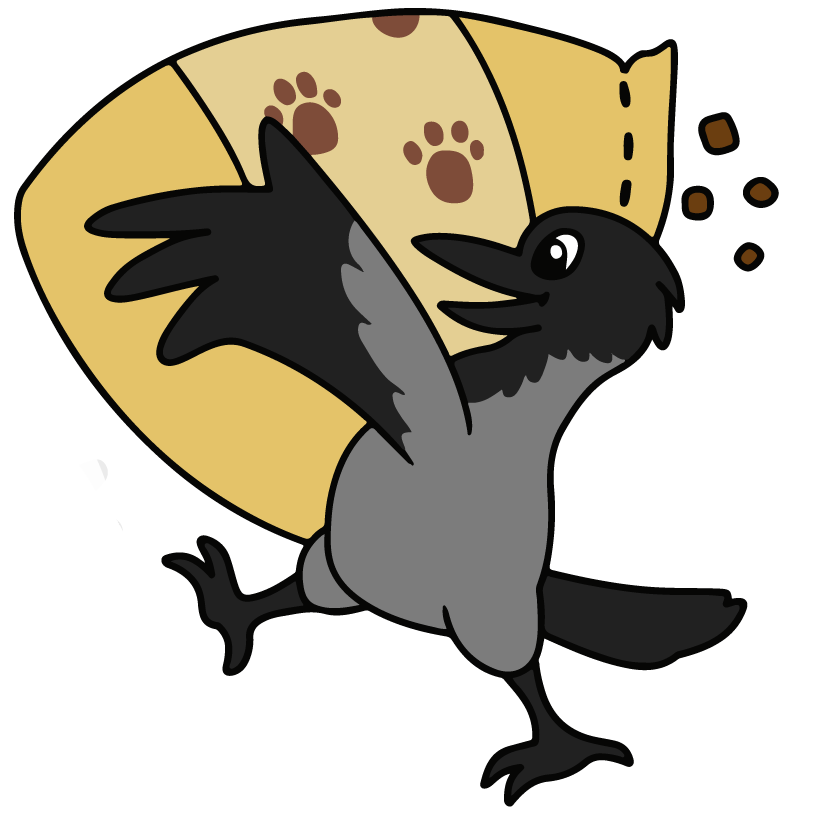The saying ”two is a pair, three is a pack” is used sometimes to describe the difference between owning one or two individual dogs and owning three or more dogs that already start to have certain pack behavior. Obviously all dogs interact together the same way, whether they live live alone or in a group, but pack behavior usually kicks in when there are more than two dogs. Pack behavior refers to behavioral patterns that are usually met in large groups of dogs. These patterns take act in situations like meeting others dogs, hunting, facing danger or alarming. It is said that a pack of dogs let loose, even if they are pet dogs, is more dangerous than a pair of dogs or just one dog. In Finland we have a saying ”joukossa tyhmyys tiivistyy”. It means you are never as stupid alone than you are in a group. Group members easily adopt behavior from others in the group, and this leads to certain behaviors becoming easily escalated. If one member of the pack is nervous, that feeling reflects to others more easily than it would if there would be just two dogs. Aggression escalates quickly, and so does the hunting behavior. It takes one of the pack to start hunting, and the rest will follow. This leads to problems if the dogs are loose and they decide instead of playing with a small dog they will now HUNT the small dog. Same happens if the pack escapes and ends up harassing lambs or other farm animals, or even people. Dogs that live in a pack form a hierarchy based on each individual and their character. No matter certain roles may change depending on the situation, it is interesting to see how each member of the pack will usually follow the role it was set to have and in many cases even chose itself. Genders have different roles in the pack, and age plays a bigger part in interactions. Balanced leaders will act firm and friendly, while those lower in the hierarchy often clown around and get away with such ridiculous behavior more easily than the ones leaders may seem as ”possible future challengers”. Alarming is one interesting feature I noticed changed significantly when I had a pack. Instead of one or two dogs each barking, a pack now seems to have different roles. When one dog alarms, others will instantly run to the one alarming and try to see the threat. The leader will then decide whether or not the threat is worth noticing. If so, it will take a dominant posture, hold it’s tail up and stare, approaching the threat if it can, while others keep alert, keep barking and follow the leader. If the leader at any point relaxes, others will eventually follow or their attitude will change from nervous and aggressive to curious, playful or indifferent. Lowest in hierarchy might even stay away from the situation, because it trusts the ”higher ups” will care for everything. When having a pack of dogs, it’s important to focus on leading the pack rather than trying to lead every individual dog. This means you need to know what causes certain behavior, and if you need to command the leading dog or leave that dog be and instead find the ”weak link” that feeds negative behavior of the whole pack. Correcting or controlling the alarming dog will not do anything, if the leading dog keeps on signaling we need to stay alert. On the contrary, if one dog is nervous about a situation, working with that individual dog will solve the whole problem while trying to calm the whole pack down each time it gets nervous makes no difference. In a pack one dog’s behavioral issue is EVERY DOG’S behavioral issue. Introducing a new family memberBringing a new dog to the pack can be frightening. What if the dogs don’t accept each other? Let’s say it here in the beginning; it is a possibility. However, you can work with issues, and in most cases that helps. In some other cases you might have to separate the dogs in one way, at least partially and at least sometimes, but even that is not the end of the world. Usually things go smoothly, and sooner or later your new dog will be part of the pack or form a good working pair with the first one.
Know your previous dog/dogs. If you have a nervous dog or an unsocial dog, introducing the newcomer in small steps is usually the best option. Ideal would be to meet the new dog a couple of times before it moves in. Collect all ”treasures” away. Very important objects might not be up for sharing just yet. After all, your dogs just met. Going for a walk together and introducing the dogs on a neutral ground works better than bringing the pup/the dog straight to the other one’s territory. A possibility to give the new dog a safe, calm place to sleep it’s first nights is also beneficial. If others are constantly trying to get to know it, it might stress both them and the new one (and vice versa, if the newcomer doesn’t leave the old dog alone). What if problems occur?Don’t let the old dog jump on the eyes of the newcomer, and don’t let the newcomer boss around the old dog. You are the authority making sure everyone feels safe and sound. Old fashioned ”leadership tricks” like rolling the dog on it’s back work only with soft dogs, and they are not based in any scientific or species related information. In the case of independent dogs and dominant dogs things like this can make the situation worse or the dog may even turn on you. The most important thing, however, is that nothing is taught this way. The effect is based on fear, not respect, and it works only with you and the dog, not to improve the situation between dogs. This is seen in many cases where people use rolling the dog on it’s back, for example, to correct it’s dominant behavior. The dog may then act OK with the human, but still bully in the pack. Nothing was taught, the problem and the source for the behavior still remains. One visible side effect was removed, that’s it. The right way to deal with possible friction between the dogs is to teach and encourage the right kind of pack behavior and to correct the dog behaving badly. How do you correct a dog like that? Well certainly not rolling it on it’s back. Physical corrections should always be used to either get the attention of the dog so you can command it to leave, stay or calm down, or to restrain the dog from harming or harassing another living being. Teaching the right kind of behavior is as important as stopping the unwanted behavior. The problem with ”The Leadership Theory” is that is doesn’t teach the dog anything, it focuses on stopping certain behavioral patterns. Smart dogs might get what you are trying to say, while nervous, aloof, dominant and temperamental dogs usually don’t. Positive reinforcement and working with the dog’s aggression and insecurities usually lead to a dog that can to certain point work and live in a pack, while some dogs never become pack animals. Keep your head cool. ”Be the boss of your dogs and all goes well!” is something you will hear if your dogs are not friends at once. While there is half the truth in that, be careful with how you acquire that position of authority, and remember; weak nerve structure will cause problems whether or not you are ”a boss”. Not all dogs are balanced, and aggressive dogs are aggressive dogs. It is dangerous to assume everything depends on how you raise the dog or socialize it. Always go for mentally balanced dogs, or then be prepared to work with those that have more complicated nerve structure. Don't be too afraid to add another dog to your pack. Knowing your current dogs and your own resources is the key to success. Another thing to ease a troubled mind; most dogs are pack animals. They might not be super social, but most get along at least with the member of opposite gender. For the majority of dogs having another dog in the family is the funniest, most awesome thing they have ever had happening. After all, we are ONLY human. There are some things only other dogs get, ya know.
2 Comments
As long as there have been people feeding commercial foods to their. dogs there has been a debate of whether or not puppy food is good for your puppies. Those in favor say puppy food is a necessity, it has all the needed vitamins and minerals in a perfect, scientifically proven balance. Those against say puppy foods are not only unnecessary but even harmful for your puppies. First, we need to understand what is puppy food. What makes puppy foods differ from adult foods or foods meant for all life stages? Why were puppy foods developed the first place? Just like with us people, little puppies need more protein and in general more balanced diet than adults. Big food companies tend to recommend using their puppy formulas, but as one goes through the ingredient list, one big question arises; there is a difference, but it is minimal. Is it really necessary to feed puppy/junior formula, if there is no real difference between the foods? Let’s take an easy road here and compare RC Adult Maxi Puppy with RD Adult Maxi (as RC has all the % in their PDFs easy to access). This is NOT to be seen as a recommendation OR a critic). You can click yourself into an in-depth site about the foods yourself and have a peek. http://pro.royalcanin.co.uk/wp-content/uploads/2014/05/Click-here-to-download-the-Maxi-Adult-Pro-Technical-Sheet.pdf http://pro.royalcanin.co.uk/wp-content/uploads/2014/05/Click-here-to-download-the-Maxi-Junior-Pro-Technical-Sheet.pdf Let’s see the first paragraph. There is no significant important difference. Omegas are a bit higher in adult food. Second paragraph lists minerals. As puppy foods are often said to have more calcium than adult foods and a different calcium-phosphorus ratio, it is pretty surprising to see there is absolutely no difference in calcium and not any kind of significant difference in calcium-phosphorus ratio. As we go lower on the list, we’ll see pretty much the same list on both sides, with a slight raise in iodine and iron in the puppy food. Next paragraph of vitamins shows no surprise; almost the exact copy. Vitamin A is slightly higher in puppy formula, and even there we don’t really speak about anything major. There is one ingredient in the whole list of ingredients that appears only in puppy formula; lutein. Lutein is an antioxidant found in spinach, broccoli and eggs, for example, and it affects eyes and skin. RC Maxi Junior has 5mgs of lutein per kg, so 0,5 mgs per 100 g (just to give you a general idea of the amount, one egg contains 0.1 to 0.3 milligrams of lutein). At least in the case with RC Maxi Adult and RC Maxi Junior the difference between formulas is so insignificant it breaks a question; does a puppy really benefit significantly of puppy food? For research purposes, I compared yet another two common foods that offer both puppy and adult formulas. Hill’s Junior Large breed differed the most from Hill’s Adult Large breed, but the changes were still very minor. Most changes were with minerals such as copper and in the increased (slightly) amount of vitamin A, while calcium-phosphorus ratio remained the same and protein and fat levels were not that far from each other. Other vitamins than the mentioned A are about if not exactly the same. In Acana Puppy Large and Acana Adult Large the difference is ridiculously small. It is in fact so small the ingredients lists are almost completely exactly the same, and the changes in them, while they appear are hardly noticeable. So, all in all, we can right here in the beginning come into conclusion that puppy formula is so close to adult formula feeding adult formula to puppies MOST LIKELY doesn’t affect them negatively. But, once again, I am no nutritional expert nor do I recommend using this blog as an ultimate truth. Research, talk to people, make your own decisions. Is puppy food harmful to the puppies? This question raises up specially among large breed owners and breeders. The issue is, there are people saying feeding puppy formula to their puppies made the puppies grow too fast, causing abnormalities in bone structure. Some people and even vets say the exact opposite; that feeding adult formula will cause bone growth issues. First suggested reason to puppy food causing problems with growth is that puppy food has too much calcium. At least in large food formulas I researched, this was not true. There was no more calcium in puppy foods or in adult foods and the ratio between calcium and phosphorus remained the same. Another possible reason is too much protein. Once more, I did not see a significant raise in protein, however puppy foods do tend to have slightly more protein. This is because puppies need protein to grow. I asked a question in a raw food group I am in, wanting to know if giant breed owners or breeders have or have not fed puppy formulas, if they have used kibble or raw, and if they have noticed abnormalities. Out of 6 people answering, one person said two puppies fed with raw food (the breeder did not identify whether the food was constructed by the owner or if it was store bought complete raw food) had developed abnormalities in bones. Four people said they had fed their puppies mostly with raw, some self constructed and some with MUSH Vaisto Puppy, and they had not met problems. One person said she had fed her puppies with both raw and kibble (she identified the kibble as puppy formula) and the puppies had grown up OK. This leads me to think, if the problem with fast growth is both genetic and caused by feeding errors. You can make a difference in general to the dog’s life with a good diet, but there are things you can’t control. You can also break a perfectly healthy dog with a poor diet. So, it is very difficult to say whether or not, in cases where abnormalities form, the main cause is genetic, wrong kind of exercise, accident or feeding. One thing to note is that abnormalities are usually met with very large/giant breeds. This leads to another possible situation; large dogs may just be so big they are getting too big for their own structure. One thing one can possibly say quite safely is that excessive/too little calcium and poorly constructed diet cause problems with growth. Puppies are much less forgiving with feeding than adults. When you feed your pup with raw food, make sure you really meet all the requirements. If you choose to go with kibble or 50 / 50, always go for a good quality kibble. If it is puppy formula or adult formula most likely does not matter. Different hobbies that require lots of energy and high drive have increased in popularity. This has led to some breeds being very hyper, aiming to produce top dogs for those certain hobbies that require exploding action. Unfortunately this also leads to certain problems with dogs of these breeds that end up just pets. How to deal with hyper breeds and/or hyper dogs, so that everyone can enjoy their life equally? |
Mistä on kyse?Koko elämänsä koiria harrastaneen raakaruokintafriikin ajatuksia, pohdintoja ja elämää koiralauman kanssa. Seuraa meitä
Päivitämme säännöllisen epäsäännöllisesti myös Facebookiin.
Historia
June 2022
Kategoriat
All
|






